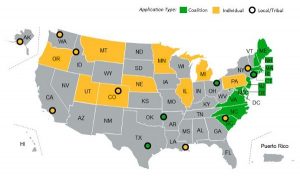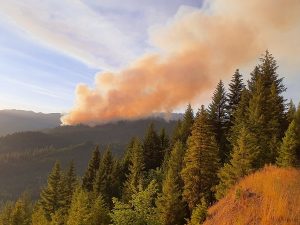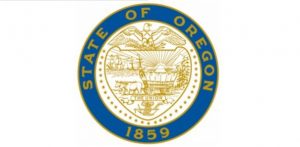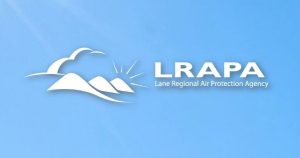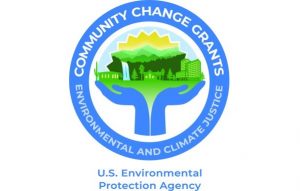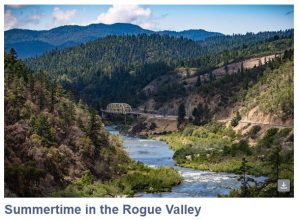Klamath restoration team hopes for a free-flowing river in time for the fall run
12 min read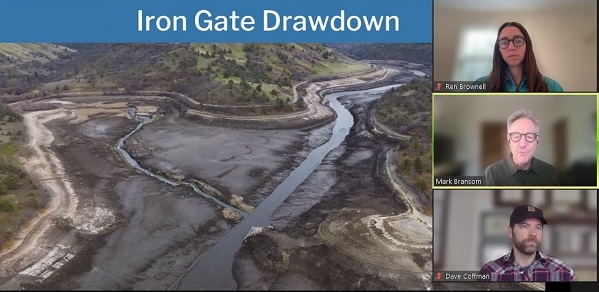
As EWEB begins a multiyear process leading to the removal of the Leaburg Dam, residents and project managers will surely draw on lessons learned from the historic restoration of the Klamath River. Earlier this year, describing plans to remove the remaining three dams in time for the fall run:
Mark Bransom (CEO, Klamath River Renewal Corporation): I’m Mark Bransom, the chief executive officer of the Klamath River Renewal Corporation. This is a very exciting time for the Klamath River Renewal Project.
[00:00:28] Just as a quick reminder, four dams make up the Lower Klamath Hydroelectric Project: the JC Boyle Dam, coming downriver, then Copco No. 1, the former Copco No. 2 dam, and the lowest of the four dams on the river, Iron Gate.
[00:00:42] These four dams basically bisect the Klamath watershed into a lower and an upper region, and of course, have blocked the migration of fish and other species up and down the river as a result of this bisection.
[00:00:57] One of the things that we accomplished during the summer and early fall of 2023 was the removal of the Copco No. 2 dam. Copco No. 2 was a small dam. It did not create a reservoir. It was a small diversion dam that diverted water released from Copco No. 1 just up above it; diverted that water from the river into a tunnel and down to a powerhouse.
[00:01:18] John Q: Drawdown of the reservoirs began in late 2023, and the initial drawdown was completed in February 2024.
[00:01:27] Mark Bransom (CEO, Klamath River Renewal Corporation): Of course the dams have been blocking the river for over 100 years, and during that period of time the presence of those dams has cut off a really important process in a healthy river system, and that is the transport of sediment.
[00:01:42] We’ve estimated that there were somewhere on the order of about 17 to 20 million cubic yards of sediment that had accumulated behind the dams over the last century, and we have projected that somewhere on the order of about a third of that sediment—or about five to seven million cubic yards—would be expected to be mobilized during the drawdown and to travel downstream through the river system, and much of that material, out to the Pacific Ocean, thereby restoring a really critical function in a healthy river system.
[00:02:13] Now for context, on average, the Klamath River moves roughly five to seven million cubic yards of sediment on an annual basis. And so we’re introducing essentially the equivalent of one year’s worth of sediment in a shorter period of time. But for context, it is being done during the winter months when we have some expectation that we’ve got the advantage of flow conditions and the least biological impacts.
[00:02:39] This was the period of the year that tribes and fisheries agencies made the decision that would be the best time of the year. We don’t have adult salmon in the river system. Most of the juveniles are up in the tributaries and have not yet started their outmigration to the ocean. And so this was really the optimal time to initiate the drawdown and to mobilize this amount of sediment and send it down the river.
[00:03:06] I just want to talk a little bit about the drawdown process. We made a decision not to utilize the historic diversion tunnel for the drawdown, simply because we did not have assurance that the tunnel was in adequate structural condition and hydraulic condition in order to handle all the flows, for the purposes of draining out the reservoir.
[00:03:27] So we made the decision to go in and create a new tunnel through the base of the dam, and utilize that for the purposes of the drawdown.
[00:03:37] It was really inspiring to watch this blast and moments after the blast to see the water and sediment begin to come out from behind the dam. And over the course of a week, we watched the process of the reservoir completely draining out and getting back down to a river condition flowing in its natural historic channel, and very inspiring to watch the river reconnect after a full century of being blocked by this dam.
[00:04:05] A lot of sediment mobilized and moved through the system, exactly according to our plans and our projections, and so we’re very pleased with the progress that has been made on the drawdown.
[00:04:17] I want to talk just a little bit about the strategy at Copco Reservoir. In the weeks leading up, we did lower the reservoir to the minimum operating pool. The purpose of doing that really was to reduce the amount of water that we needed to release, just to shorten up the time.
[00:04:33] But more importantly, we really wanted to bring the reservoir down to allow the hillsides along the reservoir rim to begin to drain out. We were aware that we had some weak geologic conditions that could have created some slope instability. And so by pre-draining these hillsides, we actually enhanced the reservoir rim stability and reduced the risk of any foundation movement or settling of the soils and the geologic material that could have impacted any of the surrounding homes.
[00:05:06] We’re going to be waiting for the spring runoff to pass through the system before we get started with dam removal. So once we get to the spring, and see the river back down to base flow conditions, we’ll get out and initiate the removal of JC Boyle, Copco No. 1 and Iron Gate more or less simultaneously.
[00:05:27] And our objective is to have completed dam removal and have restored a free-flowing river condition in the September / early October timeframe. And our goal is to be completely out of the river in time for the fall run, and to have reopened some of the upper tributaries in the mainstem for fish that may be coming through.
[00:05:48] So with that, I’m going to hand it over to Dave Coffman to talk a little bit about some of the restoration activities that are underway. Dave?
[00:05:56] Dave Coffman (Resource Environmental Solutions): Thank you, Mark. I’m Dave Coffman, Resource Environmental Solutions, program manager for restoration on the Lower Klamath project.
[00:06:02] We have been doing project-related water quality monitoring since 2022. We have crews out collecting water samples, monitoring our real-time, or taking care of our real-time water quality data sondes; that work is covered collaboratively between the Karuk Tribe and the U.S. Geological Survey.
[00:06:22] Water quality samples being collected physically every two weeks for some analytes, monthly for others. Testing being done, reporting made on a regular basis and really working to keep an eye on the short-term impacts and then eventual improvements in water quality that we see resulting from now this initialization of drawdown and dam removal on through the restoration phase of the project.
[00:06:47] We’ve had revegetation crews out on reservoir sediments since the 15th of January. So starting within a day or a few days after the drawdown of Iron Gate was initiated, we had crews on the ground starting to plant seeds that we’ve been collecting and propagating since 2018.
[00:07:06] We’ve collected 13 to 15 million seeds by hand, primarily through our partnership with the Yurok Tribe. Those seeds have been then propagated through yield-increase grows at nurseries up and down the West Coast resulting in a seed source of 17 to 20 billion seeds that have been started to be mixed into the five-plus mixes that are kind of laid down depending on the conditions that are encountered on the reservoir bottoms following drawdown.
[00:07:37] We’ve got 98 different species of plants contained within these seed mixes right now: species that can be collected (some are more difficult than others); can be propagated; and then, of course, a focus on culturally significant species.
[00:07:53] We recognized pretty early on that while these sediments, these reservoir sediments contain a decent amount of nutrients, they don’t necessarily contain those nutrients in the right chemical format. So lupine is one of the species that allows the nitrogen to be fixed through the growth process of the plant, and then become available to other plants that grow in and around the lupine.
[00:08:14] While the majority of our planting and seeding initially is being done by hand, as conditions allow, we will be mobilizing a helicopter to begin laying down seed in some of the areas where we can’t get to physically on foot because of challenging mud conditions.
[00:08:31] And so with the opportunity I have, I want to give a huge shout-out of thanks to the Yurok tribe and the Karuk tribe and the participants on this first seed collection effort that turned into a yield-increase effort done under contract with these different grow nurseries. And we’re starting to see the response of the landscape to all the hard work and preparation that’s gone into it.
[00:08:53] As the reservoir sediment has become exposed, what we’re seeing is the Klamath River in its location where we expect it to be. The river itself is going to continue to chew on deposit reservoir sediments for some time, and we will be seeding right up to the water’s edge this year to get vegetation established, to start to promote long-term stability of that remaining reservoir sediment that isn’t flushed out with drawdown and then with rains through the spring.
[00:09:20] Ren Brownell (KRRC PIO): My name is Ren Brownell. I’m the public information officer with the Klamath River Renewal Corporation. So please feel free if you have any questions to throw them into the chat. I do have one. Opponents of the dam removal say that the invasives are going to overcome the native plants. Some also say that they’re concerned about where the acorns were sourced. Could you perhaps address that, Dave?
[00:09:42] Dave Coffman (Resource Environmental Solutions): The approach that we’ve taken—recognizing that the entire landscape of the upper Klamath Basin is chock full of invasive exotic vegetation—is one of pretreatment of the surrounding landscape. Then establishment of a native vegetation cover within the reservoir footprint, an early detection and response program for IEV (Invasive Exotic Vegetation), and then a longer-term monitoring and maintenance program.
[00:10:09] So going back to pre-treatment. Prior to drawdown, for three years, we’ve had crews out treating buffers around Iron Gate and JC Boyle reservoirs for invasive species. And that’s consisted primarily of mowing. On a very limited basis, some spot herbicide application, to really limit the seed source for those exotic invasive species in the immediate vicinity of the reservoir, to hopefully limit their transport downhill into the reservoir sediments.
[00:10:37] We focused our revegetation efforts on that reservoir rim, and so we’ve got kind of a little rocky wake area along the reservoir rim, and then down into the reservoir sediments where we recognize because of the distribution or disbursement processes associated with these invasive species are, they’re most locally blow-downhill-type seed distribution. And so, once you take up the available soil real estate with native species, the invasive species aren’t able to get a foothold.
[00:11:07] Now we also spend an exorbitant amount of time on our restoration sites walking around, observing things. And so if and when we identify areas where invasive species are maybe starting to get a foothold, we don’t wait to develop a large-scale program to address those issues. We attack it head on. We’ll get out there if we have to on our hands and knees and pull these species out before they go to seed, before they’re able to cause further issues.
[00:11:31] And then that process continues for a number of years while we have our restoration obligations on the project. So that kind of covers invasive species.
[00:11:38] On the question about sudden oak death: Recognizing the concern, and of course the very real issue, we only sourced acorns from areas that had not been experiencing, or have traditionally experienced, sudden oak death.
[00:11:51] Ren Brownell (KRRC, PIO): Thank you for that, Dave. Oh, we have a couple coming through.
[00:12:00] During Siskiyou’s Board of Supervisors meeting on Tuesday, community members shared their concerns and expressed doubt in the success of this project. Is KRRC still confident that the project will accomplish its goal of restoring the Klamath River and bringing back salmon?
[00:12:13] Mark Bransom (CEO, Klamath River Renewal Corporation): Yeah, thanks for the question. I think it’s really important to note that the Klamath River is one of the most studied watersheds anywhere in the world. And, specifically there has been an awful lot of work done to better understand how the river is likely to recover. We did a significant number of studies and planning For the drawdown and dam removal.
[00:12:36] And I’m really pleased to report that all of the observations and all of the conditions that we’re seeing today, are within the boundaries of what we had anticipated. Some on the lower end, some on the higher end, but everything is going according to the conditions that we had anticipated.
[00:12:58] Given all of the work that we’ve done, what we’re seeing are temporary conditions. These sediments are going to dry out. The vegetation is going to continue to come in and the water quality is going to improve as the sediment continues to flush out. So we expect to have recovery of these important water quality parameters that we’re monitoring, that are having these impacts.
[00:13:21] And let’s just be clear that these are temporary impacts that are within the range of things that we had anticipated, things that we had communicated, things that our regulators affirmed in the permits that they issued for us. And so I think we just need to take a long view of the processes. And look, we are coming out of over a century of accumulated impacts from the presence of these dams and impacts to the rivers.
[00:13:50] So let’s take a long view and give the river some time. Previous dam removal projects and other landscape scale restoration projects give us lots to be optimistic about that. Mother Nature is going to be on the recovery and rebalance here. It’s just not going to happen overnight and we just need to take a little time and continue to give things a little light nudge where we can do so.
[00:14:13] As Dave said, job one is to stabilize the sediments in place. That’s going to go a long way to help us improve water quality and habitat conditions consistent with the goals for the project.
[00:14:23] Ren Brownell (KRRC, PIO): We have quite a few about the death, particularly about the non-native fish that we saw after initiating drawdown. So Dave, maybe could you touch on why we saw the death of these non-native species and why there wasn’t more of a relocation effort performed on these species specifically?
[00:14:43] Dave Coffman (Resource Environmental Solutions): Sure. Thanks, Ren. I think you started the response adequately by pointing out that these are non-native species that we’re seeing that have died as a result of the drawdown and changing conditions. The species that we’re primarily talking about are yellow perch, crappie, black bass, a handful of other warmwater lake species that were introduced to these impoundments for fishing.
[00:15:04] There was not an effort to capture and relocate them because they are a non-native invasive species in a river condition and shouldn’t have been here in the first place. And so the resource agencies elected to not request or require a capture relocation effort. That is why we’re seeing the mortality that we are.
[00:15:25] That goes back to the types of species that they are. They’re used to, call it either calm or slightly flowing conditions, slightly warmer water. And it was always expected that these non-native lake species would not be able to persist in a river environment.
[00:15:42] There are pockets of those species along the Klamath River in some off-channel habitat downstream. And recognizing that they’ve been washing out of these lakes for decades that have established populations down there, those habitats are fully occupied to the point where it was always expected and always conveyed that those species would be most likely flushed out during drawdown and perish, or not make it out of the reservoirs in the first place.
[00:16:08] John Q: What we can expect when EWEB draws down Leaburg: High mortality of the non-native fish, and a lot of mud. On the Klamath River, crews are stabilizing the sediments with native plants. Once the river returns to base flow conditions, crews will start removing the remaining three dams. They hope to restore a free-flowing river in time for the fall run.
